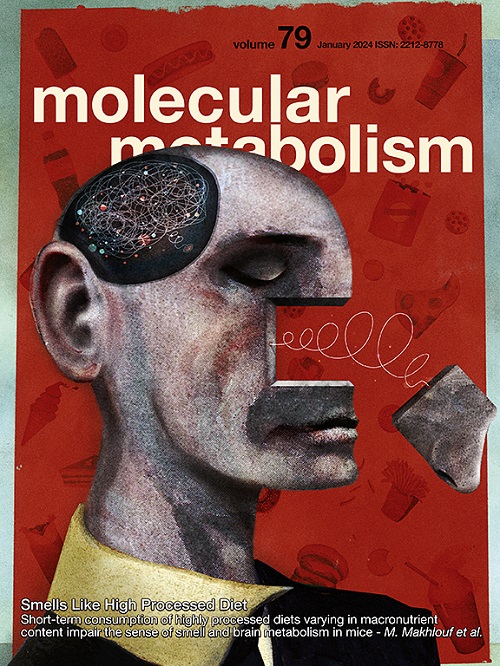Acyl CoA-binding protein in brown adipose tissue acts as a negative regulator of adaptive thermogenesis
IF 7
2区 医学
Q1 ENDOCRINOLOGY & METABOLISM
引用次数: 0
Abstract
Objective
Defective activity of brown adipose tissue (BAT) is linked to obesity and cardiometabolic diseases. While much is known regarding the biological signals that trigger BAT thermogenesis, relatively little is known about the repressors that may impair BAT function in physiological and pathological settings. Acyl CoA-binding protein (ACBP; also known as diazepam binding inhibitor, DBI) has intracellular functions related to lipid metabolism and can be secreted to act as a circulating regulatory factor that affects multiple organs. Our objective was to determine the role of ACBP in BAT function.
Methods
Experimental models based on the targeted inactivation of the Acbp gene in brown adipocytes, both in vitro and in vivo, as well as brown adipocytes treated with recombinant ACBP, were developed and analyzed for transcriptomic and metabolic changes.
Results
ACBP expression and release in BAT are suppressed by noradrenergic cAMP-dependent signals that stimulate thermogenesis. This regulation occurs through gene expression modulation and autophagy-related processes. Mice with targeted ablation of Acbp in brown adipocytes exhibit enhanced BAT thermogenic activity and protection against high-fat diet-induced obesity and glucose intolerance; this is associated with BAT transcriptome changes, including upregulation of BAT thermogenesis-related genes. Treatment of brown adipocytes with exogenous ACBP suppresses oxidative activity, lipolysis, and thermogenesis-related gene expression. ACBP treatment inhibits the noradrenergic-induced phosphorylation of p38 MAP-kinase and CREB, which are major intracellular mediators of brown adipocyte thermogenesis.
Conclusions
The ACBP system acts as a crucial auto regulatory repressor of BAT thermogenesis that responds reciprocally to the noradrenergic induction of BAT activity.

棕色脂肪组织中的酰基辅酶a结合蛋白是适应性产热的负调节因子
目的褐色脂肪组织(BAT)活性缺陷与肥胖和心脏代谢疾病有关。虽然对触发BAT产热的生物信号了解很多,但对生理和病理环境中可能损害BAT功能的抑制因子知之甚少。酰基辅酶a结合蛋白;也称为地西泮结合抑制剂,DBI)具有与脂质代谢相关的细胞内功能,可作为影响多器官的循环调节因子分泌。我们的目的是确定ACBP在BAT功能中的作用。方法建立棕色脂肪细胞体外和体内靶向灭活Acbp基因的实验模型,以及重组Acbp处理棕色脂肪细胞的实验模型,分析其转录组学和代谢变化。结果BAT中sacbp的表达和释放受到去肾上腺素能camp依赖信号的抑制。这种调节通过基因表达调节和自噬相关过程发生。靶向消融棕色脂肪细胞Acbp的小鼠表现出增强的BAT产热活性和对高脂肪饮食引起的肥胖和葡萄糖耐受不良的保护;这与BAT转录组变化有关,包括BAT产热相关基因的上调。用外源性ACBP处理棕色脂肪细胞可抑制氧化活性、脂肪分解和产热相关基因表达。ACBP治疗抑制去甲肾上腺素能诱导的p38 map -激酶和CREB的磷酸化,这是棕色脂肪细胞产热的主要细胞内介质。结论ACBP系统在BAT产热过程中起着重要的自调节抑制作用,与去肾上腺素能诱导的BAT活性相互作用。
本文章由计算机程序翻译,如有差异,请以英文原文为准。
求助全文
约1分钟内获得全文
求助全文
来源期刊

Molecular Metabolism
ENDOCRINOLOGY & METABOLISM-
CiteScore
14.50
自引率
2.50%
发文量
219
审稿时长
43 days
期刊介绍:
Molecular Metabolism is a leading journal dedicated to sharing groundbreaking discoveries in the field of energy homeostasis and the underlying factors of metabolic disorders. These disorders include obesity, diabetes, cardiovascular disease, and cancer. Our journal focuses on publishing research driven by hypotheses and conducted to the highest standards, aiming to provide a mechanistic understanding of energy homeostasis-related behavior, physiology, and dysfunction.
We promote interdisciplinary science, covering a broad range of approaches from molecules to humans throughout the lifespan. Our goal is to contribute to transformative research in metabolism, which has the potential to revolutionize the field. By enabling progress in the prognosis, prevention, and ultimately the cure of metabolic disorders and their long-term complications, our journal seeks to better the future of health and well-being.
 求助内容:
求助内容: 应助结果提醒方式:
应助结果提醒方式:


